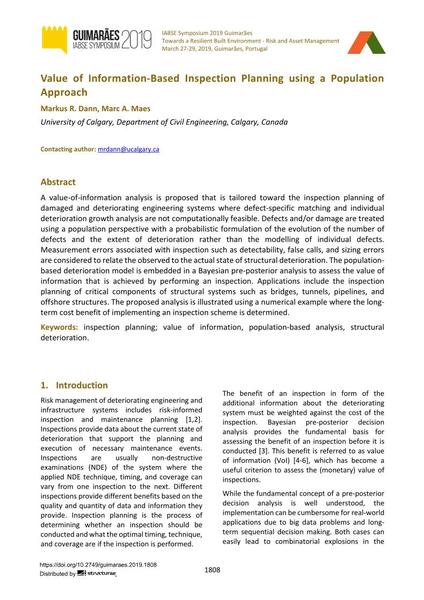Value of Information-Based Inspection Planning using a Population Approach

|
|
|||||||||||
Bibliographic Details
| Author(s): |
Markus R. Dann
(University of Calgary, Department of Civil Engineering, Calgary, Canada)
Marc A. Maes (University of Calgary, Department of Civil Engineering, Calgary, Canada) |
||||
|---|---|---|---|---|---|
| Medium: | conference paper | ||||
| Language(s): | English | ||||
| Conference: | IABSE Symposium: Towards a Resilient Built Environment Risk and Asset Management, Guimarães, Portugal, 27-29 March 2019 | ||||
| Published in: | IABSE Symposium Guimarães 2019 | ||||
|
|||||
| Page(s): | 1808-1815 | ||||
| Total no. of pages: | 8 | ||||
| DOI: | 10.2749/guimaraes.2019.1808 | ||||
| Abstract: |
A value-of-information analysis is proposed that is tailored toward the inspection planning of damaged and deteriorating engineering systems where defect-specific matching and individual deterioration growth analysis are not computationally feasible. Defects and/or damage are treated using a population perspective with a probabilistic formulation of the evolution of the number of defects and the extent of deterioration rather than the modelling of individual defects. Measurement errors associated with inspection such as detectability, false calls, and sizing errors are considered to relate the observed to the actual state of structural deterioration. The population- based deterioration model is embedded in a Bayesian pre-posterior analysis to assess the value of information that is achieved by performing an inspection. Applications include the inspection planning of critical components of structural systems such as bridges, tunnels, pipelines, and offshore structures. The proposed analysis is illustrated using a numerical example where the long- term cost benefit of implementing an inspection scheme is determined. |
||||
| Keywords: |
Inspection planning value of information population-based analysis structural deterioration
|
||||
